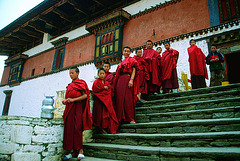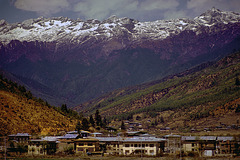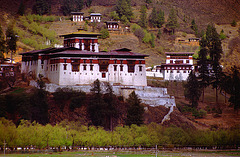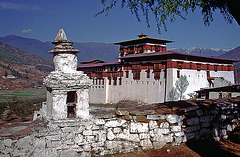Wolfgang's photos
Monks in front the Rinpung Dzong in Paro
| |
|
The daily life of the monk is austere, particularly if they are stationed at one of the monasteries located high in the mountains. At these monasteries food is often scarce and must be carried up by the monks or their visitors. The monks are poorly clothed for winter conditions and the monasteries are unheated. The hardship of such a posting is well-recognized; to have a son or brother serving in such a monastery is recognized as very good karma for the family.
Ta Dzong in Paro
| |
|
Overlooking the Rinpung Dzong it was built in 1951 as a watch tower, unlike the rectangular shape of the Dzongs, Ta Dzong is Round, more like parts of an European castle. From 1967 the Dzong was re-established as the National Museum and holds fascinating collection of arts, relics, religious thangkha, and many others.
Kyichu Lhakhang Monastery
| |
|
The origin of Kyichu Lhakhang dates back to the seventh century, it is one of the oldest and most sacred shrines of Bhutan (the other is Jambey Lhakhang in Bumthang). Kyichu Lhakhang is composed of twin temples, the first temple was built by Buddhist Tibetan King, Songtsen Gampo in the 7th century and in 1968, H.M. Ashi Kessang, the Queen Mother of Bhutan, arranged for a second temple to be built alongside the first one, in same style.
Dog meat butcher at a market in Hanoi
| |
|
|
Dog meat is very common to eat in Vietnam, Laos, China, Thailand northeast, Burma, Indonesia and many other countries in southeast Asia. Close your eyes, try it, eat it and you'll like it if it isn't you own dog.
Inside Văn Miếu (Temple of Literature) in Hanoi
Special wine sorts for your health
| |
|
|
A tasty alternative to the german, french or italian wine.
However, these claims should not all be taken literally as many are likely exaggerated to attract buyers. It is illegal to import snake wine to many countries including the United States because the cobras and other snakes killed in the production are often endangered species.
Children welcome us at the entrance door
| |
|
|
Before we entered the Tự Đức Mausoleum complex we met a group of pupils waiting for the entrance too. It was Incredible how every kid try to use his english knowledge starting a conversation with us. This much shortened our waiting time for the entrance.
Along the Huong River (Perfume River)
| |
|
|
|
Huong River also called Perfume River is a main waterway in Vietnam.
A river that crosses the city of Hue, in the central Vietnamese province of Thua Thien-Hue Province.
In the autumn, flowers from orchards upriver from Hue fall into the water, giving the river a perfume-like aroma, hence the sobriquet.
Children welcome us at the Bình Thuận Desert
| |
|
|
When we met this kiddies we were very surprised about their demands what they were asking for. Instead of asking for a candy, chewing gum, pencil or for a coin they claimed like: "Please adopt me!"
The Thongdrol enrolled
| |
|
|
This Thanka, the Thongdrol, is the second largest Thanka on the world, (the largest is in Lahsa/Tibet and is enrolled in Aug. every year at the Sera monasterry Lhasa). The people enroll it during nighttime only due a very high sensibility that the sunlight will destroy the nice color. Visitors at the Tshechu Paro have to get up very early at nighttime to see the Thanka, which is enrolled once a year.
View into the Dolpo valley
Paro Dzong
| |
|
This was the view from our farm house where we stayed during our visit in Paro. We just stepped over a cabbage field we reached the beautiful alley leading to the Paro Bridge and to the Dzong.
The Paro Dzong from northern side
| |
|
|
The Paro Dzong, also called Rinpung Dzong, was started in 1644 on the order of Shabdrung Ngawang Namgyal, the unifier of modern day Bhutan. Unlike most of the other dzongs in Bhutan, it survived the massive 1897 earthquake mostly unscathed, though it was damaged by fire in 1907.
Sha-Zami, The dance of the deers
| |
|
A scene out of the performance during the Paro festival called Paro Tsechu.
The red deers symbolize the savers of the humanity.
Shhanag, The dance of the black hats
| |
|
Welcome dance of the Lamas
| |
|
|
The Lamas (priests) enter the yard playing the Nga (drum), the Kangling (trumpet), the Gyaling (oboe) and the Rolmo (cymbals).
The enrolled second biggest Thanka (Thongdrol)
| |
|
On the last day of Tsechu, rise before dawn to attend the display of the great Thongdrol. An intricately appliqued and embroidered silk scroll measuring 12,20 x 18,30 meter. This work of art pictures the eight manisfestations of Guru Rinpoche, the Second Buddha and the founder of Tantric Buddhism. Thangkas such as this one are regarded as great treasures and are displayed only once a year for a few hours. It is believed that the mere sight of the Thongdrol brings salvation to the beholder. The festival area fills with people from all over the country well before dawn. People offer butter lamps and receive Thongdrol blessings. Monks dance cheerfully beating on double-sided drums with curved drumsticks. The Thongdrol is then let down to the ground and ceremoniously rolled and folded away before the first rays of the sun can reach it. Following the display of the Thongdrol, the Tsechu continues throughout the day with the performances of several additional dances.
Thanka enrolled at the Paro Tsechu
| |
|
|
At the Paro Festival, a large and beautifully appliquéd Thanka scroll known as a Tongdrol is exhibited for a few hours, at day break of the final day of the festival, enabling the people to obtain its blessing, as this holy scroll confers liberation by the mere sight of it (Tongdrol in Bhutanese).


















